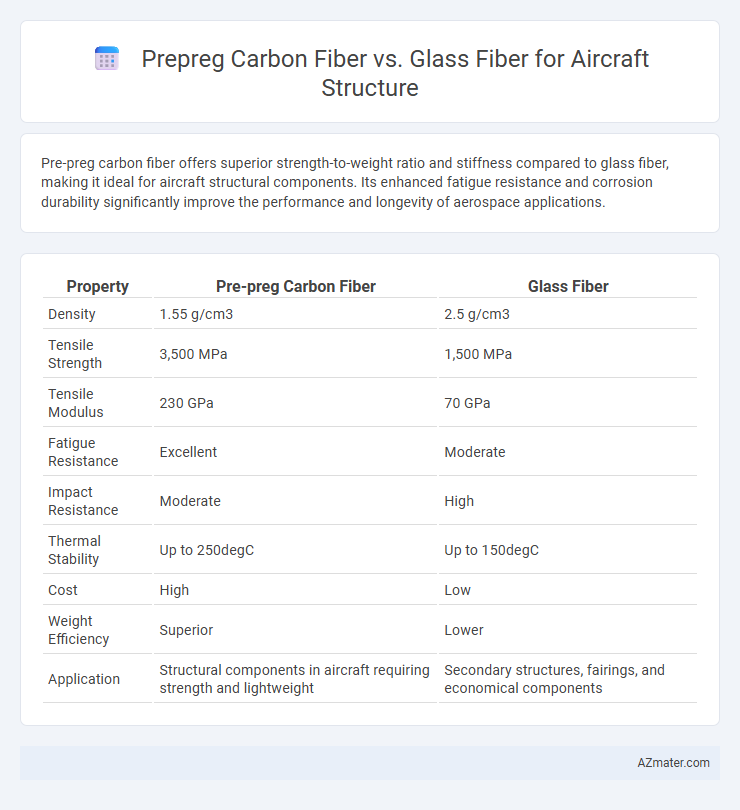Pre-preg carbon fiber offers superior strength-to-weight ratio and stiffness compared to glass fiber, making it ideal for aircraft structural components. Its enhanced fatigue resistance and corrosion durability significantly improve the performance and longevity of aerospace applications.
Table of Comparison
| Property | Pre-preg Carbon Fiber | Glass Fiber |
|---|---|---|
| Density | 1.55 g/cm3 | 2.5 g/cm3 |
| Tensile Strength | 3,500 MPa | 1,500 MPa |
| Tensile Modulus | 230 GPa | 70 GPa |
| Fatigue Resistance | Excellent | Moderate |
| Impact Resistance | Moderate | High |
| Thermal Stability | Up to 250degC | Up to 150degC |
| Cost | High | Low |
| Weight Efficiency | Superior | Lower |
| Application | Structural components in aircraft requiring strength and lightweight | Secondary structures, fairings, and economical components |
Introduction to Composite Materials in Aviation
Pre-preg carbon fiber and glass fiber are essential composite materials widely used in aircraft structures due to their high strength-to-weight ratios and corrosion resistance. Carbon fiber composites offer superior stiffness and fatigue resistance compared to glass fiber, making them ideal for primary structural components in modern aerospace engineering. Glass fiber composites provide cost-effective solutions with good impact resistance, often applied in secondary structures and interior components within aviation applications.
What is Pre-preg Carbon Fiber?
Pre-preg carbon fiber is a composite material consisting of carbon fiber reinforced with a pre-impregnated resin matrix, typically epoxy, ensuring uniform resin distribution and optimal fiber-to-resin ratio. This material offers superior strength-to-weight ratio, high stiffness, and excellent fatigue resistance, making it ideal for critical aircraft structures where weight reduction and structural integrity are paramount. Compared to glass fiber, pre-preg carbon fiber provides enhanced mechanical properties and thermal stability, crucial for demanding aerospace applications.
Understanding Glass Fiber for Aircraft Structures
Glass fiber for aircraft structures offers high strength-to-weight ratios and excellent corrosion resistance, making it suitable for non-critical load-bearing components and secondary structures. Its cost-effectiveness compared to pre-preg carbon fiber allows widespread use in applications such as fairings, radomes, and interior panels without significantly compromising structural integrity. Glass fiber composites also exhibit good impact resistance and electrical insulation properties, enhancing durability and safety in various aerospace environments.
Weight Comparison: Carbon Fiber vs Glass Fiber
Pre-preg carbon fiber offers a significantly lower weight compared to glass fiber, making it a preferred choice for aircraft structures where weight reduction is critical for fuel efficiency and performance. Carbon fiber's higher strength-to-weight ratio enables the fabrication of lighter yet stronger components than glass fiber composites. This weight advantage of carbon fiber directly translates into enhanced payload capacity and improved aerodynamic efficiency in aviation applications.
Strength and Durability Differences
Pre-preg carbon fiber offers superior tensile strength and stiffness compared to glass fiber, making it ideal for high-performance aircraft structures requiring high load-bearing capacity. Carbon fiber's enhanced fatigue resistance and lower weight contribute to improved durability and fuel efficiency, while glass fiber tends to exhibit lower strength-to-weight ratios and higher susceptibility to environmental degradation. These material properties make pre-preg carbon fiber the preferred choice for critical structural components demanding long-term reliability and exceptional mechanical performance.
Manufacturing and Processing Techniques
Pre-preg carbon fiber offers superior strength-to-weight ratio and enhanced fiber alignment, making it ideal for high-performance aircraft structures, while glass fiber is more cost-effective with easier handling but lower mechanical properties. Manufacturing with pre-preg carbon fiber involves precise temperature-controlled curing cycles in autoclaves to achieve optimal resin consolidation and fiber-matrix bonding, ensuring high structural integrity. Glass fiber processing typically uses wet lay-up or vacuum infusion methods, which are less complex but result in higher resin content and reduced performance compared to carbon fiber composites.
Cost Analysis: Pre-preg Carbon vs Glass Fiber
Pre-preg carbon fiber offers superior strength-to-weight ratios compared to glass fiber, justifying its higher initial material costs in aircraft structures. While glass fiber remains more affordable upfront, the long-term benefits of pre-preg carbon fiber--such as reduced maintenance, improved fuel efficiency, and enhanced fatigue resistance--contribute to lower overall lifecycle expenses. Cost analysis reveals that investing in pre-preg carbon fiber can result in significant savings over the operational life of an aircraft despite its premium price.
Performance Under Stress and Fatigue
Pre-preg carbon fiber offers superior tensile strength and stiffness compared to glass fiber, enhancing aircraft structure performance under high stress conditions. Its higher fatigue resistance enables longer service life and improved durability in cyclic loading environments typical of aircraft operations. Glass fiber, while cost-effective and corrosion-resistant, generally exhibits lower strength and fatigue properties, making it less ideal for critical structural applications.
Applications in Modern Aircraft Design
Pre-preg carbon fiber offers superior strength-to-weight ratio and fatigue resistance, making it ideal for critical aircraft structural components such as fuselage panels, wing spars, and tail surfaces in modern aircraft design. Glass fiber composites, while less expensive and providing good corrosion resistance, are primarily used in secondary structures and interior components due to their lower stiffness and strength compared to carbon fiber. The adoption of pre-preg carbon fiber in aerospace applications significantly enhances fuel efficiency and performance by reducing overall airframe weight without compromising structural integrity.
Conclusion: Choosing the Right Material for Aircraft Structures
Pre-preg carbon fiber offers superior strength-to-weight ratio, fatigue resistance, and thermal stability compared to glass fiber, making it ideal for high-performance aircraft structures requiring enhanced durability and weight reduction. Glass fiber remains a cost-effective option with good corrosion resistance and impact tolerance, suitable for less demanding structural components or where budget constraints exist. Selecting the right material depends on balancing performance requirements, budget, and long-term maintenance considerations in aircraft design.

Infographic: Pre-preg Carbon Fiber vs Glass Fiber for Aircraft Structure
 azmater.com
azmater.com